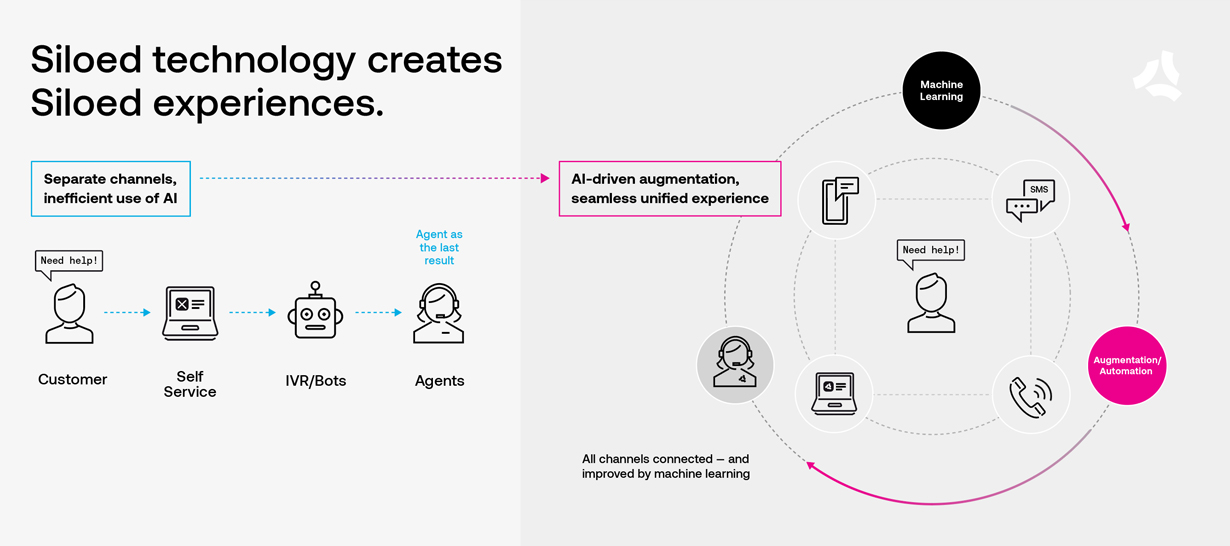Automation should help resolve, not deflect
The mission of Solution Design at ASAPP is to help companies identify areas of massive opportunity when it comes to optimizing their contact centers and digital customer experiences. At the highest level, we aim to help our customers provide an extremely personalized and proactive experience at a very low cost by leveraging machine learning and AI. While we’ve seen many different cost saving and personalization strategies when it comes to the contact center, the most common by far is as follows:
- Step 1:
Leverage self service channels (website, mobile apps, etc) built by digital teams and hope customers resolve issues themselves or buy products directly. - Step 2:
If customers aren’t able to solve issues on their own, offer “assistance” using an IVR or chatbot, with the goal of preventing customers from talking to an agent. - Step 3:
When these fail, because the question is too complex or there isn’t an easy way to self serve, have an agent handle it as quickly as possible, often starting from scratch.
It’s a strategy that many Fortune 500 companies were convinced would revolutionize the customer experience and bring about significant cost savings. Excited by the promises of chatbot and IVR companies who said they could automate 80% of interactions within a year—which they assumed would reduce the need for agents to handle routine tasks– companies spent millions of dollars on these technologies.
Automation as you know it isn’t working
While some are seeing high containment numbers put forth in business cases, the expected savings haven’t materialized—as evidenced by how much these companies continue to spend on customer service year after year. Furthermore, customers are frustrated by this strategy—with most people (myself included) asking repeatedly for an agent once they interact with an IVR or bot. The fact is, people are calling in about more complex topics, which require knowledgeable and empathetic people on the other end of the line.

We live in a new era where the companies who can provide extremely efficient and personalized interactions at a lower cost than their competitors are winning out.
Austin Meyer
It’s not surprising that in 2019, executive mentions of chatbots in earnings calls dropped dramatically and chatbot companies struggled to get past seed rounds of investment (cite). These programs cost millions of dollars in software and tooling, and double or triple that for the labor involved with building, maintaining, measuring, and updating logic flows. Beyond NOT increasing contact center efficiency, chatbot technology has reduced customer satisfaction, impeded sales conversion, and has caused the market to missassociate AI with automate everything or nothing.
A better automation strategy
We live in a new era where the companies who can provide extremely efficient and personalized interactions at a lower cost than their competitors are winning out.
There has been a retreat from using bot automation to avoid customer contact. Instead, leading companies are using ML and AI to improve digital customer experiences while simultaneously helping agents become more efficient. Furthermore, by connecting the cross channel experiences and using machine learning across them, conversational data is much more complete and more valuable to the business.
Compared to the earlier strategy, where there were distinct walls between self service, automation and agents, this new strategy looks far more blended. Notice that automation doesn’t stand alone—instead, it’s integrated with the customer experience AND agent workflows. Machine learning provides efficiency gains by enabling automation whenever appropriate, leading to faster resolution regardless of channel.

At ASAPP, we use AI-driven agent augmentation and automation to improve customer experience and increase contact center efficiency. The results have been transformative—saving our customers millions of dollars in opex, generating millions in additional revenue while dramatically improving CSAT/NPS and digital engagement. If you want to learn more about our research, results, or strategy reach out to me at solutions@asapp.com.







